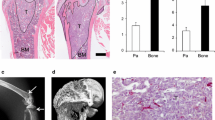Abstract
Breast cancer affects approximately one woman in twelve and kills more women than any other cancer. If detected early, patients have a five year survival rate of 66%, but once metastatic disease has developed, there is no effective treatment. About 70% of patients with metastatic disease have bone involvement, while lungs and liver are the other common targets. Bone metastases cause severe pain, pathological fractures and hypercalcaemia and thus are a significant clinical problem. The development of new therapies for metastatic breast carcinoma depends on a better understanding of the mechanism of homing of the tumour cells to bone, liver and lungs and the factors required for their growth in these organs. Research on mechanisms of breast cancer metastasis, particularly to bone, has relied on in vitro studies or on tumour models in which the inoculation route is designed to promote delivery of tumour cells to a specific organ. Metastases in bone are achieved by inoculation into the right ventricle of the heart. To our knowledge there has been no report of a model of metastatic spread from the mammary gland to distant sites which reliably includes bone. In this paper, we describe our recent development of a novel murine model of metastatic breast carcinoma. The new model is unique in that the pattern of metastatic spread closely resembles that observed in human breast cancer. In particular, these murine breast tumours metastasise to bone from the primary breast site and cause hypercalcaemia, characteristics not normally found in murine tumours, but common in human disease. Furthermore, in a preliminary characterisation of this model, we show that secretion of parathyroid hormone-related protein, a role for which has been implicated in breast cancer spread to bone, correlates with metastasis to bone. This model therefore provides an excellent experimental system in which to investigate the factors that control metastatic spread of breast cancer to specific sites, particularly bone. The special advantage of this system is that it involves the whole metastasis process, beginning from the primary site. Existing models consider mechanisms that pertain to growth of tumour once the site has been reached. An understanding of the regulation of these factors by potential therapeutic agents could lead to improvement in therapies designed to combat metastatic disease. For the first time, this development will allow exploration of the molecular basis of site-specific metastasis of breast cancer to bone in a clinically relevant model.
Similar content being viewed by others
References
Mundy GR. Mechanisms of bone metastasis. Cancer 1997; 80: 1546–56.
Mundy GR, Yoneda T. Mechanisms of bone metastasis. In: Orr FW, Singh G (eds) Bone Metastasis - Mechanisms and Pathophysiology: New York: Springer-Verlag 1996; 1–16.
Crichton MB, Nichols JE, Zhao Y, Bulun SE, Simpson ER. Expression of transcripts of interleukin-6 and related cytokines by human breast tumors, breast cancer cells, and adipose stromal cells. Mol Cell Endocrinol 1996; 118: 215–20.
Lacroix M, Siwek B, Marie PJ, Body JJ. Production and regulation of interleukin 11 by breast cancer cells. Cancer Lett 1998; 127: 29–35.
Oates AJ, Barraclough R, Rudland PS. The identification of osteopontin as a metastasis-related gene product in a rodent mammary tumour model. Oncogene 1996; 13: 97–104.
Gillespie MT, Thomas RJ, Pu ZY, Zhou H, Martin TJ, Findlay DM. Calcitonin receptors, bone sialoprotein and osteopontin are expressed in primary breast cancers. Int J Cancer 1997; 73:812–15.
Guise TA. Parathyroid hormone-related protein and bone metastases. Cancer 1997; 80: 1572–80.
Price JE. Metastasis from human breast cancer cell lines. Breast Canc Res Treat 1996; 39: 93–102.
Kjønniksen I, Winderen M, Bruland Ø, Fodstat Ø. Validity and usefulness of human tumor models established by intratibial cell inoculationin nude rats. Cancer Res 1994; 54: 1715–19.
Arguello F, Baggs RB, Eskenazi AE, Duerst RE, Frantz CN. Vascular anatomy and organ-specific tumor growth as critical factors in thedevelopment of metastases and their distribution among organs. Int J Cancer 1991; 48: 583–90.
Miller BE, Roi LD, Howard LM, Miller FR. Quantitative selectivity of contact-mediated intercellular communication in a metastatic mouse mammary tumor line. Cancer Res 1983; 43: 4102–7.
Aslakson CJ, Miller FR. Selective events in the metastatic process defined by analysis of the sequential dissemination of subpopulations of a mouse mammary tumour. Cancer Res 1992; 52: 1399–405.
Kartsogiannis V, Moseley JM, McKelvie B, Chou ST, Hards DK, Ng KW, Martin, TJ, Zhou, H. Temporal expression of PTHrP during endochondral bone formation in mouse and intramembranous bone formation in an in vivo rabbit model. Bone 1997; 21: 385–92.
MacIsaac RJ, Caple IW, Danks JA, Diefenbach-Jagger H, Grill V, Moseley JM, Southby, J, Martin, TJ. Ontogeny of parathyroid hormone-related protein in the ovine parathyroid gland. Endocrinology 1991; 129: 757–64.
Grill V, Ho P, Body JJ, Johanson, N, Lee SC, Kukreja SC, Moseley, JM, Martin, TJ. Parathyroid hormone-related protein: elevated levelsboth in humoral hypercalcemia of malignancy and in hypercalcemiacomplicating metastatic breast disease. J Clin Endocrinol Metabol 1992; 73: 110–15.
Meyer T, Hart IR. Mechanisms of tumour metastasis. Eur J Cancer 1998; 34: 214–21.
Paget S. The distribution of secondary growths in cancer of the breast. Lancet 1889; 1: 571–73.
Guise TA, Yin JJ, Taylor SD, Kumagai Y, Dallas M, Boyce BF, Yoneda, T, Mundy, GR. Evidence for a causal role of parathyroid hormone-related protein in the pathogenesis of human breast cancer-mediated osteolysis. J Clin Invest 1996; 98: 1544–49.
Rankin W, Grill V, Martin TJ. Parathyroid hormone-related protein and hypercalcemia. Cancer 1997; 80: 1564–71.
Author information
Authors and Affiliations
Rights and permissions
About this article
Cite this article
Lelekakis, M., Moseley, J.M., Martin, T.J. et al. A novel orthotopic model of breast cancer metastasis to bone. Clin Exp Metastasis 17, 163–170 (1999). https://doi.org/10.1023/A:1006689719505
Issue Date:
DOI: https://doi.org/10.1023/A:1006689719505




